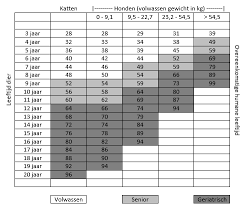Every animal ages, but when are they a senior? And, what can I do?
– Written by IC Koutzarov, owner Big Dog Company –
Our animals are getting older, and although you would like to, you cannot stop time. But fortunately we have enough 'tools' to detect certain age-related diseases early, to remedy them, to slow them down, or to relieve the pain. How do you recognize if your dog is a senior? And what should you do if your dog is a senior? We discuss that in this article.
In short, you can divide the stages of a dog's life into:
- Puppy
- Junior
- Adult
- Senior
- Geriatric
But when is my dog or cat a senior? Although a dog/cat ages faster than humans, the statement "1 dog year is equal to 7 human years" is too simplistic. Among other things, the size of the breed plays a major role, a Great Dane (unfortunately) does not live as long as a Chihuahua. In addition, there are other factors that play a role: genetics, nutrition, external and internal stress factors.
Dr. Richard T. Goldston has developed a table comparing the ages of dogs and cats to the ages of humans. Here you can clearly see that the heavier (larger) the dog/cat, the sooner the senior stage is reached.
My dog is senior according to the table
You may now be looking with furrowed eyebrows because you don't notice that your dog is senior (old). Yes, he has a few more gray hairs around his snout and eyes, but he still runs around the Forest with ease every day.
Good thing, too!
Being a senior does not necessarily mean being sick/less active! But reaching this stage does mean that the years will play tricks on your four-legged friend, especially on the inside, for example:
- The animal moves less and is slower and sniffs more, which can lead to obesity.
- Conversion processes, such as protein synthesis, are less efficient
- The peristalsis of the intestines is slower (passage speed of food)
- Burning and absorption of food reduced
- Organs work less efficiently, for example the filter function of proteins in the kidneys.
Measuring is knowing…
When your dog reaches senior age, you can regularly (once a year, the older the more often) have a blood and urine test carried out by your vet (geriatric profile, incl. SDMA). This provides insight into, among other things:
-
- Number of red/white blood cells, the volume of the cells, and their size
- Whether there are inflammatory cells (which may indicate inflammation in the body)
- The organs are tested: thyroid, liver, pancreas and kidneys (the kidneys are often the first to show age-related problems. Ask the vet for the SDMA test
- B12: you can opt to include extra B12 in the blood test
- Urine: The PH value of the urine and the extent of any protein loss (kidneys)
- For other, unexplained symptoms (coughing, wheezing, frequent stretching) you can also have an ultrasound scan of the organs. This is how I found out Muffin had a tumor on her spleen.
Based on the results, you could possibly adjust the food and adjust the diet with supplements. This will be a topic for a future newsletter. In the meantime, if you have any questions, you know where to find us! (info@bigdog.nl)


